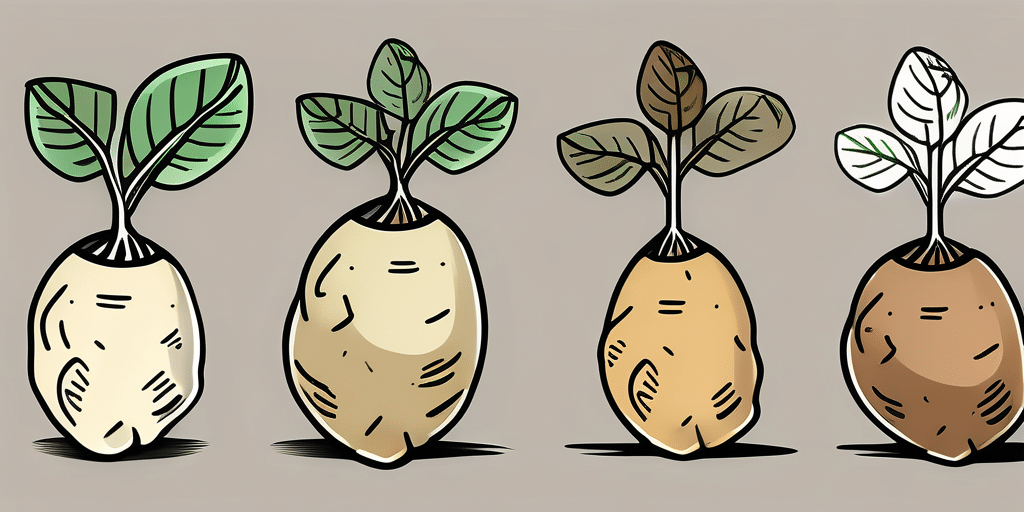Planting potatoes is a rewarding endeavor that can yield a bountiful harvest. Whether you’re a seasoned gardener or a beginner, this guide will provide you with the knowledge and skills you need to successfully grow your own potatoes.
Understanding Potatoes
Potatoes are a versatile crop that can be grown in a variety of climates and soil types. They are a staple food in many cultures and are rich in vitamins and minerals, making them a nutritious addition to any diet.
According to the United States Department of Agriculture (USDA), potatoes are the world’s fourth-largest food crop, following rice, wheat, and maize. They are grown in over 100 countries and are consumed in a variety of ways, from mashed and fried to baked and boiled.
The Life Cycle of a Potato
Potatoes are a tuberous crop, which means they grow underground from a plant’s stem or root. The potato plant’s life cycle begins when a seed potato is planted in the ground. The seed potato sprouts, producing stems and leaves that grow above ground, while the roots and tubers develop below ground.
As the plant matures, the tubers continue to grow and multiply. Once the plant’s foliage begins to die back, the tubers are ready to be harvested. This typically occurs 70 to 120 days after planting, depending on the variety of potato.
Choosing the Right Potato Variety
There are over 4,000 varieties of potatoes worldwide, each with its own unique characteristics. When choosing a potato variety to plant, consider your climate, soil type, and personal taste preferences.
Some popular potato varieties include Russet, Yukon Gold, and Red Pontiac. Russet potatoes are known for their starchy texture and are ideal for baking and frying. Yukon Gold potatoes have a buttery flavor and creamy texture, making them perfect for mashing. Red Pontiac potatoes are versatile and can be used in a variety of dishes.
Climate Considerations
Potatoes are a cool-season crop and prefer temperatures between 60 and 70 degrees Fahrenheit. They can tolerate light frost, but prolonged exposure to cold temperatures can damage the plants and reduce yield.
According to the USDA, potatoes grow best in regions with cool, moist summers and mild winters. However, they can be grown in warmer climates if planted early in the spring or late in the summer for a fall harvest.
Preparing to Plant
Before you can plant your potatoes, you’ll need to prepare your soil and seed potatoes. Proper preparation can help ensure a successful harvest.
Preparing the Soil
Potatoes prefer well-drained, loamy soil with a pH between 5.0 and 7.0. To prepare your soil for planting, start by removing any rocks or debris. Then, amend the soil with compost or well-rotted manure to improve its fertility and drainage.
According to Purdue University Extension, it’s also a good idea to have your soil tested to determine its nutrient levels and pH. This can help you choose the right amendments and fertilizers for your soil.
Preparing the Seed Potatoes
Seed potatoes are small potatoes or pieces of potatoes that are used to grow new potato plants. To prepare your seed potatoes for planting, start by choosing healthy, disease-free potatoes. Then, cut the potatoes into pieces, making sure each piece has at least one or two eyes (the small indentations from which new plants sprout).
Once your seed potatoes are cut, let them sit at room temperature for a few days to allow the cut surfaces to dry and form a protective layer. This process, known as curing, can help prevent rot and disease.
Planting Your Potatoes
Now that your soil and seed potatoes are prepared, you’re ready to plant. Here’s a step-by-step guide to planting potatoes:
- Dig a trench about 3 to 4 inches deep in your prepared soil.
- Place your seed potatoes in the trench, cut-side down, spacing them about 12 inches apart.
- Cover the seed potatoes with soil, leaving about 1 inch of soil above the seed potatoes.
- Water the newly planted potatoes thoroughly.
According to the USDA, potatoes should be planted in the early spring, as soon as the soil can be worked. However, they can also be planted in the late summer for a fall harvest in warmer climates.
Caring for Your Potato Plants
Once your potatoes are planted, they’ll need regular care to ensure a healthy harvest. This includes watering, fertilizing, and hilling.
Watering
Potatoes need consistent moisture to grow properly. Too little water can result in small, misshapen potatoes, while too much water can cause the potatoes to rot. Aim to water your potatoes once a week, providing about 1 to 2 inches of water each time.
Fertilizing
Potatoes are heavy feeders and benefit from regular fertilization. Apply a balanced vegetable garden fertilizer when you plant your potatoes, and again when the plants start to flower.
Hilling
Hilling is the process of piling soil around the base of your potato plants. This helps protect the developing tubers from sunlight, which can cause them to turn green and become bitter. Hill your potatoes when the plants are about 6 inches tall, and again every few weeks as they continue to grow.
Harvesting Your Potatoes
When it’s time to harvest your potatoes will depend on the variety you planted and your desired use for the potatoes. New potatoes, which are small and tender, can be harvested as soon as the plants start to flower. For larger, mature potatoes, wait until the plants have died back completely.
To harvest your potatoes, use a garden fork or spade to gently lift the potatoes from the ground. Be careful not to damage the potatoes as you harvest them, as this can lead to rot.
Once harvested, let your potatoes sit in a cool, dry place for a few days to cure. This helps to toughen the skin and extend the potatoes’ storage life.
Conclusion
Planting potatoes can be a rewarding experience, providing you with a bountiful harvest of this versatile crop. With the right preparation and care, you can successfully grow your own potatoes, whether you’re a seasoned gardener or a beginner. Happy planting!
Join the How to Grow Everything Community
Ready to take your gardening skills to the next level? Subscribe for free to How to Grow Everything and learn how to build the garden of your dreams! Receive personalized gardening advice tailored to your location, grow zone, and experience. Enjoy the best gardening tips, special offers, and insights delivered straight to your inbox—no spam, just valuable information to help you grow everything successfully. Become part of our family and join thousands of gardeners who trust us for their gardening articles and guides. It’s 100% free, from our family to yours.

